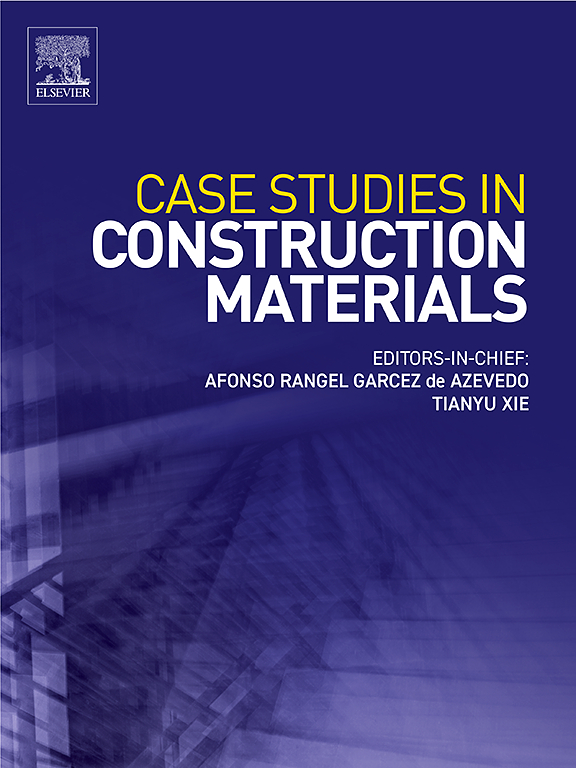Sustainable geopolymer adsorbents utilizing silica fume as a partial replacement for metakaolin in the removal of copper ion from synthesized copper solution
IF 6.5
2区 工程技术
Q1 CONSTRUCTION & BUILDING TECHNOLOGY
引用次数: 0
Abstract
Biochar has great significance for controlling heavy metal pollution. Nevertheless, its application is impeded by certain shortcomings, such as a limited adsorption capacity, a slow adsorption rate, and poor reusability. Besides, the physical adsorption capacity of raw biochar to heavy metals is suboptimal. As a result, researchers prefer to use geopolymer-based adsorbents for the removal of heavy metals due to their excellent immobilization effect. However, no research has been done on the synthesis of geopolymer-based adsorbent using silica fume for heavy metal adsorption. Thus, the aim of this study is to partially replace metakaolin (MK) with silica fume (S1) (25, 50, 75 and 100 %) in geopolymer formulation at varied S:L ratio (0.4, 0.6, 0.8 and 1.0) to study the impact on the geopolymerization and its following properties in the removal efficiency of copper (Cu2 +). Characterization techniques such as Energy dispersive X-ray fluorescence (EDXRF), X-ray diffraction (XRD), Fourier-transform infrared spectroscopy (FTIR), Scanning electron microscope (SEM) and Energy dispersive X-ray spectroscopy (EDX) were used to study the physicochemical properties of the developed geopolymer. The concentration of Cu2+ before and after adsorption was determined by Atomic absorption spectroscopy (AAS) and the removal efficiency was calculated. Based on the experimental result, the geopolymer prepared with 25 % MK and 75 % S1 at S:L of 0.6 maintained the high removal efficiency of Cu2+ (99.62 %) with 100 % MK geopolymer (98.56 %). The generation of N-A-S-H gel with the 75 % replacement level of S1 producing more reactive Si and Al binding sites for Cu2+ adsorption. In addition, S1 contains exchangeable cations such as Ca2+, Mg2+ and Na+ which further promote the adsorption of Cu2+ by ion exchange. Moreover, the mechanisms such as chemical bonding and precipitation were involved in the adsorption of Cu2+. Hence, this research could serve as a basis for the development of solid waste based geopolymers that could remove heavy metal ions from aqueous solution.
可持续地聚合物吸附剂利用硅灰作为部分替代偏高岭土在去除铜离子合成铜溶液
生物炭对控制重金属污染具有重要意义。然而,它的应用受到一些缺点的阻碍,如吸附能力有限,吸附速度慢,可重复使用性差。此外,生炭对重金属的物理吸附能力不理想。因此,研究人员更倾向于使用基于地聚合物的吸附剂来去除重金属,因为它们具有良好的固定效果。然而,利用硅灰合成地聚合物基吸附剂吸附重金属的研究尚未见报道。因此,本研究的目的是在不同的S:L比(0.4、0.6、0.8和1.0)下,用硅灰(S1)(25、50、75和100 %)部分取代地高岭土(MK),研究对地高岭土聚合及其对铜(Cu2 +)去除效率的影响。利用能量色散x射线荧光(EDXRF)、x射线衍射(XRD)、傅里叶变换红外光谱(FTIR)、扫描电镜(SEM)和能量色散x射线能谱(EDX)等表征技术研究了所制备的地聚合物的物理化学性质。采用原子吸收光谱法(AAS)测定吸附前后的Cu2+浓度,并计算其去除率。实验结果表明,在S:L = 0.6条件下,以25 % MK和75 % S1制备的地聚合物与100 % MK的地聚合物(98.56 %)相比,对Cu2+的去除率高达99.62 %。生成的N-A-S-H凝胶具有75% %的S1替代水平,产生更多的活性Si和Al结合位点,以吸附Cu2+。此外,S1中还含有Ca2+、Mg2+、Na+等交换阳离子,进一步促进了离子交换对Cu2+的吸附。吸附Cu2+的机理包括化学键和沉淀等。因此,本研究可作为开发固体废物基地聚合物去除水溶液中重金属离子的基础。
本文章由计算机程序翻译,如有差异,请以英文原文为准。
求助全文
约1分钟内获得全文
求助全文
来源期刊

Case Studies in Construction Materials
Multiple-
CiteScore
7.60
自引率
19.40%
发文量
842
审稿时长
63 days
期刊介绍:
Case Studies in Construction Materials provides a forum for the rapid publication of short, structured Case Studies on construction materials. In addition, the journal also publishes related Short Communications, Full length research article and Comprehensive review papers (by invitation).
The journal will provide an essential compendium of case studies for practicing engineers, designers, researchers and other practitioners who are interested in all aspects construction materials. The journal will publish new and novel case studies, but will also provide a forum for the publication of high quality descriptions of classic construction material problems and solutions.
 求助内容:
求助内容: 应助结果提醒方式:
应助结果提醒方式:


